Day 1: Introduction to wetlands, their functions, values & importance
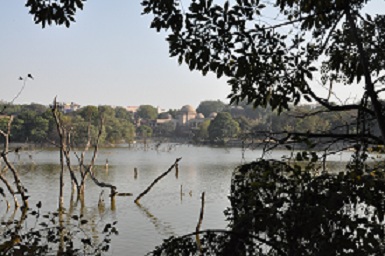
Urban wetland in Hauz Khas village, Delhi (Image: Sabita Kaushal)
Manu Bhatnagar began with an in depth introduction to wetlands and watershed, why we need them and how the regional hydrology affects these water bodies.
Wetlands are basically submerged or water saturated lands, either man-made or natural, permanent or temporary, with water that is static, flowing, fresh or saline , whose depth does not exceed 6 m at low tide ! As per this all encompassing, broad definition adopted by Ministry of Environment and Forests, even rice fields are considered as wetlands.
These wetlands are a highly productive environment, sometimes called the kidneys of the ecosystem, acting as cradles of biodiversity. They fulfil the important hydrological functions of flood retention, groundwater recharge and water purification ! They provide habitat and nesting grounds to various living creatures, act as food resources and carbon sinks.
The watershed, also called the drainage basin, is all of the land and water areas that drain toward a particular river or lake. A lake reflects its watershed's size, topography, geology, land use, soil fertility and vegetation.

Watershed: Area of land over which water drains towards a lake or river (Source: mckeancountypa.org)
It was surprising to learn that there is no specific definition for lakes in India. The word “lake” is used loosely to describe many types of water bodies – natural, manmade and ephemeral including wetlands. Many of them are euphemistically called lakes more by convention and a desire to be grandiose rather than by application of an accepted definition. Vice versa, many lakes are categorized as wetlands while reporting under Ramsar Convention (only global environmental treaty that deals with the wetland ecosystem).
Lake ecology in terms of its physical, chemical and biological aspects was then detailed. What came to the fore, was the important understanding that each lake or water body is a complete entity in itself, differing both spatially and temporally in its variability.
Though we tend to visualize a lake as a uniform mass of water, almost like a full bath tub that is evenly mixed from top to bottom, side to side and front to back; in reality, these are extremely heterogeneous, or patchy having variable characteristics.
Ritu Singh spoke on the functions and values of these wetlands in terms of hydrology, habitats, and how they provide both recreational and urban biodiversity. Another interesting titbit was how lakes and ponds are differentiated only on the basis of size, which again is not quantified ! How these wetlands take on a more important role in tropical areas along with the various types of wetlands found in India, like the marshes, mangroves, swamp forests etc, was illustrated.
Day 2: Effects of urbanisation and eutrophication
After a basic understanding of water bodies, the effect of urbanization on regional hydrology was introduced by Manu. Once an area moves into a high-paced development phase, urbanisation of the watershed aggravates. The impact of development is felt more in the change of the catchment's characteristics Roads, boundary walls and pavements come up, and encroachment of the drainage area occurs. This not only results in the lowering of the water table, but the water body too slowly begins to deteriorate, more often than not ending up as a recipient of sewage and effluents.
How the menace of land acquisition and reclamation by local bodies shrivels up local wetlands was aptly demonstrated by the example of Bhalsawa lake in north Delhi. Rapid and haphazard urbanisation led the catchment area of Hauz Khas lake in Delhi to come down from 10 sq km in 1936 to less than 2 sq km today, which is more than an 80 % reduction.
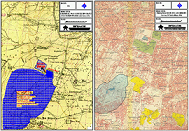
Catchment area reduced by 80 % due to urbanisation in Hauz Khas village, Delhi (Image source: INTACH)
Manu spoke on water budgeting and how water balance needs to be maintained to keep a lake eco system healthy. The leading threat to water quality –eutrophication, which is basically an over-enrichment of water through nutrients was elaborated upon. As per the Millenium Ecosystem Assessment (MA) it has been found that human activities have resulted in the near doubling of nitrogen and tripling of phosphorus flows to the environment when compared to natural values.
Two of the most acute and commonly recognized symptoms of eutrophication are harmful algal blooms, commonly known as red/brown tides and hypoxia, formation of dead zones in the water body. The source, impact and control methods of these excess nutrients including testing and recycling of nutrients was also touched upon.
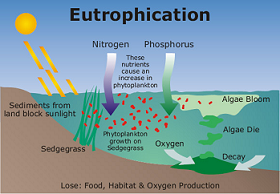
Eutrophication: Excessive nutrients leads to an ecosystem collapse (Image source: 05lovesgeography)
Lake management and conservation methods that need to be followed were clarified. The edge of a water body may be protected by providing a buffer zone, fencing its perimeter and encouraging vegetation on its edges. Similarly both catchment areas and the water sources may be addressed by following various in situ and ex situ measures.
Day 3: Case studies and conservation approaches undertaken

Intervening embankment and land reclamation disconnects Bhalsawa lake from Yamuna river (Image source:INTACH)
Case studies of two lakes - Bhalsawa and Hauz Khas lakes in Delhi were taken up. Bhalsawa lake in north Delhi is an oxbow lake (an u-shaped body of water formed when a wide meander from the main stem of a river is cut off to create a lake), a part of the flood plain area of the Yamuna river. Survival of the lake was at stake, due to disconnection from the river due to intervening embankments and land reclamation. The initial survey carried out, analysis and the proposed plan of action were discussed.
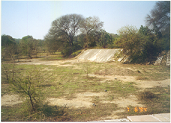
Hauz Khas lake bed in 2003 (Image source: INTACH)
The Hauz Khas lake had lost 80% of its catchment area since 1936 and the lake bed was a dry, barren pit. A scheme was envisioned and conservation work carried out to restore the lake to its former glory. Water from a nearby Sewage Treatment Plant (STP) was diverted after bio-remediation, passing through various check dams in Sanjay Van.

Water from STP flowing throughcheck dams built in Sanjay Van (Image: Sabita Kaushal)
The site visit to the lake and Sanjay Van, was an eye opener. The check dams, the flora fauna present, the aerators for maintenance in the lake - all were contributors to a healthy ecosystem. Today the lake is home to various migratory birds, a sight for sore eyes in water-deficient Delhi and testimony to the fact that we can be a part of the change we wish to see.
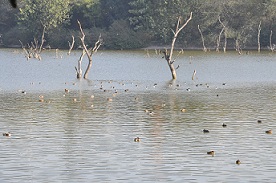
Hauz Khas lake restored and revived (Image: Sabita Kaushal)
For more information on the course, click here.
/articles/understanding-and-conserving-urban-lakes-and-wetlands-report-course-conducted-intach-new